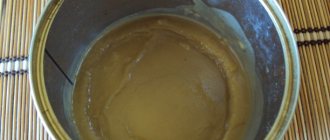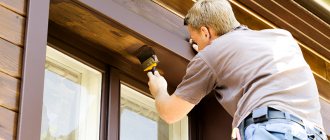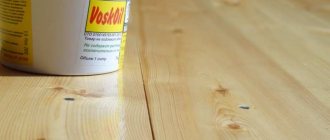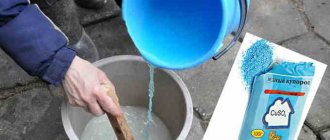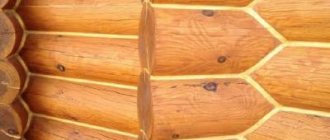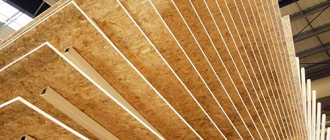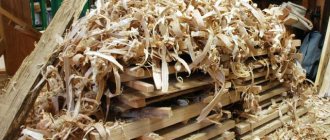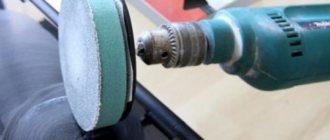Repairing wooden floors: is it necessary to saturate the surface with drying oil?
Do I need to coat a wooden floor with drying oil before painting?
For what purpose? How many layers should I apply? Which drying oil is best to use? After applying drying oil, a protective film appears on the boards, protecting the lumber from moisture, rot, and parasites. The board must absorb drying oil, so previously the liquid was rubbed into the boards, and the floors in the bathhouse were soaked in hot drying oil. If the floor is not impregnated with protective liquids, it will crumble within a few years. Apply drying oil in one layer with a brush.
For indoor work, natural drying oil is recommended. It is made from processed products of linseed or sunflower oils. Natural drying oil is odorless, but expensive. Alkyd drying oils are cheaper; when working, it is necessary to constantly ventilate the room due to the pungent odor. A floor impregnated with drying oil must be painted.
Now, in addition to drying oil, there are better wood impregnations.
Drying oil is a film-forming substance, but it is not an antiseptic.
That is, thanks to that very film, the wood will be protected from moisture, that’s all (although in the case of floors this is one of the most important points).
Drying oil can be applied if you plan to paint the floors with oil paint (it is based on drying oil).
And of course, there is a point in using drying oil if the board is new and has not yet been treated with anything (including paint).
It is better to take natural flaxseed drying oil.
Apply in several layers (at least two).
Before application, it makes sense to heat the drying oil in a water bath and only then can it be used.
It is better to work with brushes, although if the area is large, you can try with a roller, but a brush is better.
Another plus of drying oil is that less paint will be used and, most importantly, it (the paint) will lie evenly.
So if there is a choice between drying oil and no drying oil at all, then of course drying oil is better.
When purchasing, be careful, there is a lot of “left-handed” drying oil in the markets.
It’s a little more difficult to answer about the floor. I’ll answer about a similar wooden product. At my dacha, the entire corridor and staircase are decorated with pine clapboard. But there is no difference.
Fully. When finishing, we were worried about hornets and other insects that could grind all this wood into dust. Plus, in winter the dacha is not heated. Changes in temperature and so on can have a bad effect on the condition of the lining.
But the guy who helped install the lining definitely insisted on covering each plank with natural drying oil. Although I wanted varnish.
For several years, this lining has not dried out, and the bug has not touched it.
It is definitely necessary to impregnate the wood during repairs.
Floorboards (new, fresh, planed, of course) must be treated on the rough side with an antifungal agent.
The front side of the boards should be covered with drying oil (preferably natural) in two steps. The first layer of drying oil will dry almost immediately before your eyes.
Drying oil is applied for two reasons: it disinfects, protects the wood and saves paint and varnish materials, which you will quite possibly use to cover the floor. Or maybe you won’t do this.
If you have excellent, top-quality floorboards, then you may like the natural structure of the wood after applying drying oil in two stages. Then you can go over the floor with drying oil for the third time, and fix the result with a varnish based on natural drying oil.
Source
What is drying oil needed for: what does it do and how to use it correctly
Wood is now one of the most fashionable and popular construction and finishing materials due to its two main characteristics: environmental friendliness and aesthetics.
But at the same time, wood is not highly durable and durable compared to other modern materials. Natural wood requires special processing technology and additional protection; for this purpose, various impregnations, mastics, etc. are used.
Decorative coating with drying oil
Drying oil, almost forgotten in recent years due to the abundance of new products from foreign manufacturers in this category, is again in increasing demand - the effect is almost the same, but the price is much more affordable.
Why is drying oil needed and how to use it correctly when finishing a house or other building (for example, a gazebo or bathhouse) made of wood?
Operating principle of oil impregnation
In the sun and warmth, the composition becomes thick; being in such climatic conditions, the substance begins to dry out, forming a film. The polymerization process occurs due to the presence of glycerides, which are more abundant in hemp and flaxseed oil. With other types of oils, a complete step-by-step drying process does not occur; such a composition may not completely dry out at all.
To reduce the time required to complete all stages of polymerization, the product is heated and a drier is added to it. This composition can be applied to various types of wooden materials (fibreboard, OSB, chipboard, plywood, wood). A thin layer will dry from 6 to 36 hours. The result is a thin protective film.
Impregnation of wood with drying oil is suitable for improving adhesion with other materials - paintwork materials, wax.
A thin layer will dry from 6 to 36 hours.
What is drying oil
Drying oil is a traditional paint and varnish material, widely used in construction and painting work several decades ago.
The basis of the product is any vegetable oil - sunflower, linseed, rapeseed or soybean, plus additional substances that form a waterproof film on the surface of the wood, protecting it from the formation of mold, mildew, rot and the effects of parasitic insects.
Under the Soviet Union, this was almost the only means used to process wooden products and buildings. He has his ardent admirers to this day.
Wood coating process
The impregnation process is not complicated. First you need to prepare the item; it must be cleaned of all possible types of contamination and degreased. Before coating with drying oil, you must wait until the surface is completely dry.
You can use a hot impregnation method; for this, the product is placed in a solution in a water bath, where it should remain for 4-5 hours, after which it is removed and left to dry for several days. Or they perform standard surface painting.
First you need to prepare the item; it must be cleaned of all possible types of contamination and degreased.
Using drying oil for wooden walls
Drying oil helps reduce paint consumption, which is why it is often applied to wood not only as a protective layer, but also as a primer for painting. How to do this correctly?
Everything is extremely simple. Shake the bottle of product, or pour it into a large container and stir.
Drying oil is used to dilute oil paints
DIY corner bath lampshade
There is no need to prepare the walls in any special way - drying oil is not a varnish, after applying this product, small wood fibers will not rise up, forming small spines.
No sanding is required after complete drying.
Using a wide brush, apply drying oil like a regular primer, without skimping, but also not in such a way that it drips off - you will only extend the drying time; the performance characteristics of the wood will not improve from excess drying oil.
Why else do you need drying oil for wood? With its help, you can give the wood a certain shade, especially if you coat it with an additional varnish, not a transparent one, but a tinting varnish.
You can also add it to thick colored paint - it will not lose its qualities, and you will save on material consumption.
Description of the substance
Drying oil for wood is used by many, because this remedy has been known for a long time. After applying the substance, a film is formed on the surface, which serves as a barrier against biological influences; it also protects the wood from moisture. It is obtained by thermal processing of oils of plant origin; other components are added to improve their qualities.
There are also types of material that are created from artificial oils. New materials have appeared that have excellent performance for external use; they have relegated drying oil as a means for external surface treatment to the background. Nowadays, painting with drying oil is more often done for interior finishing of wood products.
After applying the substance, a film is formed on the surface, which serves as a barrier against biological influences; it also protects the wood from moisture.
Using drying oil for the floor
Many people are interested in why drying oil is needed for the floor and whether it is needed at all. A primer coating for wood floors is necessary in any case. But what to choose – drying oil or another product is everyone’s personal choice.
Drying oil is the cheapest, but it has its own smell and is not enough to protect the wood well from moisture and abrasion.
It is worth noting that floors coated with drying oil must dry for several days before applying the next layer.
So, if you don’t have time, it’s better not to save money and look for another primer for a wooden floor.
Additional Information
Drying oil can be used for priming not only wooden walls, but also plastered ones. It is also often used as an anti-corrosion coating for metals.
It is important to choose the right type of product. A modern manufacturer produces drying oil of three varieties, different in composition and properties:
Natural drying oil. It consists of 95% vegetable oil, and only 5% of drier, a special additive that accelerates the drying of the treated surface.
It is unprofitable to use it for treating external surfaces due to high financial costs, while this type does not provide 100% protection against fungus and insects.
Natural drying oil is used to dilute oil paints and prime wooden surfaces before painting or varnishing.
Oxol. It consists of 55% natural oil component, 40% solvent, white spirit, and 5% drier. The scope and properties of this type of drying oil are the same as natural ones, only it dries faster and costs less.
It also does not provide 100% protection. Learn more about why Oxol drying oil is needed and what it consists of in the video:
Composite drying oil is made entirely from artificial chemical components, in particular petroleum-polymer resins, and has a pungent odor.
This type is strictly not recommended for treating interior spaces, otherwise you will be haunted by an unpleasant odor in the rooms for many months, not to mention possible intoxication when working with this product.
Drying oils based on alkyd resins are considered the best. They are not as greasy and expensive as natural drying oils, and not as toxic as composite ones. But, nevertheless, it is better to use them for finishing outdoor country buildings (porch, swing, gazebo, summer kitchen) and for the interior rooms of country houses and apartments.
Choose more modern, purified, reliable and safe formulations.
Cover the wood with drying oil
Drying oil is a good alternative to modern expensive means for impregnating and priming wooden surfaces.
But remember that some types can be toxic and are not suitable for use in residential areas.
If you need guaranteed protection from external factors, drying oil alone is not enough.
Noticed a mistake? Select it and press Ctrl+Enter to let us know.
Source
Why do you need drying oil for wood?
Impregnation of natural wood with drying oil performs several important functions:
These characteristics and properties of drying oil are achieved thanks to its unique operating principle. On wood treated with drying oil, an elastic and at the same time durable film is formed. It does not allow water to pass through and provides complete protection.
The properties of drying oil are best demonstrated if applied in 3 layers. This allows you to achieve maximum efficiency and at the same time save on finishing (enamel or paint).
The composition of drying oil slightly affects its functions. There are several types of this paint and varnish material, and each of them has its own advantages and disadvantages.
Drying oil drying time
How long it will take to dry a surface treated with drying oil depends on the method of application and the type of product:
- If the “hot method” using a water bath was used, it will take 4-5 days;
- Oil impregnation with kerosene dries in 2-3 days, with turpentine and paraffin in 48 hours;
- With wax in the composition – from 48 to 72 hours.
Oil impregnation with kerosene dries in 2-3 days, with turpentine and paraffin in 48 hours.
Varieties of drying oils
Complete environmental friendliness allows you to use drying oil for both external and internal woodwork. At the same time, for indoor treatment it is better to choose natural ones, although synthetic ones are not toxic.
Natural
This drying oil for wood is the most environmentally friendly. It is completely safe for health and can be used for internal treatment even in a children's room.
Natural drying oil is always produced according to GOST, which provides it with the following properties:
Due to the reduced content of driers, natural drying oil hardens a little faster than other varieties. It is often used to dry sheathing and other wood structures that do not require painting.
Semi-natural
Like natural drying oil, semi-natural oil is also based on oils. But their volume is slightly lower and usually does not exceed 55% of the total volume of liquid.
As a rule, semi-natural drying oil is not used “on its own”, but as an additive to:
In addition to driers, it uses a solvent, so there is a persistent unpleasant odor. The treated room has to be ventilated for a long time to get rid of it.
renting a three-room apartment in nizhny novgorod
This type is very cheap. But due to fairly rapid wear, it cannot be used as a finishing layer - only under enamel or paint.
Combined
The combined preparation is made according to the following principle - 30% solvent to 70% natural oil. The result is a clear, slightly yellowish liquid. It is not suitable for decorative finishing, so it is most often used under oil paint (both facade and interior).
Treating wood with a combined drying oil provides good moisture protection and reliably repels insects.
Alkyd
Many experts believe that it is best to dry wood with compositions based on alkyd resins. The advantages are obvious - reduced toxicity (compared to composite and synthetic drying oils), as well as low price (compared to natural ones).
“Alkyd” can be used for exterior and interior work, but it is not recommended in rooms where children spend a lot of time.
Synthetic (polymer)
This variety uses synthetic oils instead of natural oils. There are no requirements in GOST, which does not have the best effect on quality. Moisture protection is very weak, and the chemical smell does not disappear for a long time.
The only way to use synthetic drying oil is to add it to putty and plaster mixtures. The low price encourages this.
Compositional
This type contains oxidized oils (rapeseed, linseed or cottonseed) and gasoline diluted with rosin. Due to this composition, it is not recommended to dry interior walls.
Composite drying oil is used, as a rule, as a base for varnish or enamel. But it also looks good as a finishing layer.
Saving Tips
Prices for high-quality drying oil can be expensive. Therefore, in order to save product, you can resort to making it yourself. The components are inexpensive, you just need to spend time on the cooking process itself. And be careful with hot oil. The cooking steps were described above. You can also resort to diluting the composition, although this may reduce the resulting effect.
You can resort to diluting the composition, although this may reduce the resulting effect.
Is it necessary to dry wood before painting? The answer is yes, if certain types of coloring compounds are used. Drying oil can be an excellent protective agent for wooden surfaces; natural compositions are suitable for treating surfaces inside the house. It is important to choose quality products.
Wood treatment with drying oil for exterior use
Using drying oil for external treatment is an excellent way to protect wood from damage and extend its service life. This preparation is resistant to temperature changes and does not prevent the tree from “breathing”.
To treat walls with drying oil, you need to proceed as follows:
You can limit yourself to 3 layers - they are enough to provide good protection to the wooden surface. But many people prefer to repeat the procedure until the oily liquid stops being absorbed - this requires 3 to 5 layers depending on the type and condition of the wood.
An important point is that the wood must be dry before starting treatment. Otherwise, the average consumption of drying oil per 1 m2 of wood will increase significantly.
How to dilute drying oil
Fresh, just purchased liquid does not need to be diluted with anything. This is a completely ready-to-use material. It is diluted only if it has stood open for quite a long time and has had time to harden or thicken.
To dilute the drug, you can use:
When mixing, strict proportions must be observed - no more than 1 part solvent per 10 parts drying oil. Otherwise, the drug will lose its qualities.
An important point - if the drug has been left open for more than 1 year, then it should be thrown away. Even if it can be returned to a liquid state, it will do more harm to the tree than good.
Drying time
The drying period directly depends on the type of product and application features:
Thus, in most cases it will take no more than 24 hours to dry.
How to dilute drying oil
If the solution has been standing for too long, and the seal of the container has been broken, then it must be diluted before use. Natural solvents are suitable for this. White spirit, turpentine, nefras, etc. can be used. If the product is already very hardened, fill it with thinner and leave for several hours, then stir and apply to the surface.
If the product is already very hardened, fill it with thinner and leave for several hours.
How to make and store drying oil
Despite the fact that a wide range of drying oil for wood is sold in hardware stores, some people prefer to make it themselves. Especially if you have accumulated quite a lot of vegetable oil (linseed or sunflower) in your household.
To make the drug yourself, you need:
An important point is that potassium permanganate (potassium permanganate) is used as a drier. Thanks to it, the drying oil dries and hardens after application. You can use other catalysts, but potassium permanganate is the easiest to buy - it is cheap and available in every pharmacy.
The cooking process is quite simple:
It’s very easy to check whether homemade drying oil is ready. You need to drop it on transparent glass. If the drop itself looks transparent, the drug is ready.
The service life of drying oil prepared at home is no lower than that of a store-bought one. The main thing is to follow fire safety precautions when creating it. In particular, you should not fill more than half the container with oil, because it will splash in all directions.
Storage conditions for the drug (both purchased and homemade):
Source
We make drying oil ourselves
If you wish, you can prepare the product yourself; the best way is to use linseed oil, but you can also choose sunflower oil. First, prepare the oil base. To do this, pour the oil into the container, fill it halfway, turn on the stove, and wait for the oil to heat up to 100-120 degrees. When these temperatures are reached, water will evaporate and foam will appear. After it subsides, heating is carried out for 3-5 hours, the temperature should reach 270 degrees.
Drying agent is being prepared. 100 particles of rosin by weight are taken, which are melted in a special container at 150 degrees. When the foam settles, 5 particles of manganese peroxide are gradually introduced. The temperature is increased to two hundred degrees, left for 3 hours, the finished material turns out transparent.
Add a desiccant to the container with the oil, making the heat low, and monitor the level of foam. When the foam has completely subsided, the composition is boiled for 5-10 minutes, then removed to cool.
If you wish, you can prepare the product yourself; the best way is to use linseed oil, but you can also choose sunflower oil.
Is it possible to paint over drying oil and what paint is best to do this?
Any person sooner or later faces the need for repairs. Today on the construction market there are many tools and materials that will help you update your interior or exterior on your own. One way is to paint interior wooden surfaces - window frames, doors, floors or even walls.
where do cockroaches hide in an apartment during the day?
Many people do not approach this issue seriously, so they buy the first available (that is, cheap) paint and start working without first preparing the surface, which becomes the main mistake.
If we are talking about a clumsy process with a roller, the result of which is visible on every fence, then the direction has been chosen correctly. But at the heart of any well-done finishing operation is attention to detail, which should be taken care of in advance. Otherwise, you can not only waste time, effort and money, but also completely ruin the consumables and the wooden object itself.
Therefore, it is important to take into account the nuances. For example, what to do if the wooden surface was previously covered with a coloring or strengthening solution: varnish, paint, impregnation or drying oil? The last composition is more problematic than the others, so, first of all, you need to figure out: with what and how to paint the drying oil previously applied to the surface of the wooden material?
To answer this question, you should get a little closer to such a construction archaism as drying oil, and understand why its use nowadays causes such heated debate, both in the professional community and in amateur circles?
Required tools and materials
If impregnation of large surfaces is used, then apply the solution with standard tools:
- Brush;
- Roller;
- Spray gun;
- A rag made of natural fabric.
You will also need the drying oil itself and sandpaper.
You need to paint carefully so that the composition penetrates into all the details. Apply the composition in at least two layers, each layer must dry.
If impregnation of large surfaces is used, then apply the solution with standard tools.
Features and disadvantages of drying oil
Drying oil is a film-forming liquid consisting of sediments of vegetable oil (linseed, hemp, sunflower, mulberry, etc.), which is processed in a special way (overheating or oxidation). And the solvents and driers in its composition are similar to oil paints, varnishes, primers and putties. In other words, drying oil as a finishing mixture can be used as any lubricating or coloring raw material.
Drying oil is both a coloring agent and an impregnating agent.
In the Soviet years, oil paint based on drying oil was almost the only available means of painting surfaces. It was applied to literally everything: floors, walls, ceilings, doors, windows and even furniture. When removing worn-out wallpaper layer by layer, old tiles in the bathroom or worn-out linoleum, there is a high probability that you will come across an oiled surface. Previously, not a single repair could be done without it.
With the appearance of new paint and varnish mixtures on the shelves of construction stores, drying oil began to be used only for putty purposes in order to give integrity to the porous structure of the material and protect it from moisture. Due to its viscous composition, drying oil has good filling properties, which significantly reduces its consumption. Another area of its application is painting metal surfaces and walls and ceilings in service areas (toilet, locker room, industrial kitchen) where there are hoods. In addition, it is used to prime concrete surfaces and renew wood in exterior work.
With all its advantages, drying oil has a number of significant disadvantages, of which those who have at least once tried to apply another paint and varnish substance to it without pre-treatment are well aware. Among the obvious disadvantages it should be noted:
It must be said that all of the above negative aspects are for the most part characteristic of low-quality, cheap drying oil. A good coating only partially has them.
It would seem that it is simply impossible to re-paint a surface impregnated with drying oil. But the situation is not as dire as it seems at first glance. The main thing is to choose the right tools and paint.
How can you prime fiberboard?
Priming for oil and alkyd paints:
- The most inexpensive and effective primer option for fiberboard is natural drying oil;
- It penetrates deeply into the thickness of the material and reliably protects it from moisture;
- The impregnated surface has good adhesion to oil paints and alkyd enamels;
Interesting materials:
How to glue linoleum onto a concrete floor? What did Malinovsky command? What to feed Minecraft turtles? What to feed your Dzhungarik hamster at home? What to feed salmon in Minecraft? What to feed young cockatiels? What to feed a donkey in Minecraft? What to feed a one-month-old Scottish kitten? What to feed swifts at home? What is the best way to feed goldfish?
Choosing paint and tools
When working with oiled material, choosing the right paint is of paramount importance. Anyone who tried to put paint on drying oil invariably noticed: the freshly applied coating “bubbles” as it dries, and the opened bubbles have a yellow, resinous content and a characteristic smell of drying oil.
Still, there are several types of dyes and finishing materials that I can cope with the difficult drying oil. These include:
Any of these options is perfect for painting not only wood, but also concrete and metal surfaces. You should not try to paint drying oil with quick-drying nitro enamel or water-based paint: our cunning oil-based impregnation will simply “repel” the layer of paint. To use water-dispersion and water-based paint, the surface must be thoroughly washed and cleaned, removing the film from the drying oil. In this case, 2-3 layers of water-based paint will cover the surface, but, unlike other compositions, will not saturate it.
Several new devices are purchased for the standard set of tools:
To apply self-adhesive film you need:
Everything you need is at hand. Nothing prevents you from getting to work.
Surface preparation
The importance of pre-treatment of the oiled surface has been discussed more than once. Only a short-sighted amateur who does not feel sorry for his wasted efforts and money on materials can omit the preparatory stages. A thrifty owner would prefer to do everything once, but thoroughly and well.
So, here is the sequence in which the processing work needs to be carried out:
These carefully completed stages will greatly facilitate the application of paint and prevent their deformation throughout their entire service life.
Do I need to dry wood before painting?
Beginners often ask the question: Do I need to dry wood before painting? The question is really appropriate, because even experts do not give an exact answer. The thing is that the answer depends on the type of paint chosen. For oil-based products, it is necessary to treat the surface with drying oil before application. For alkyd enamels, similar woodworking is recommended.
The use of this pre-treatment of the surface for other types of paintwork materials may be undesirable; the coloring agent may not adhere to the coating, or may crack after time, this also applies to water-based and acrylic compositions.
For oil paints, it is necessary to treat the surface with drying oil before application.

